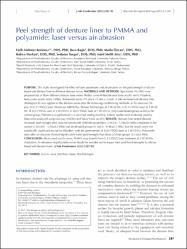| dc.contributor.author | Korkmaz, Fatih Mehmet | |
| dc.contributor.author | Bağış, Bora | |
| dc.contributor.author | Özcan, Mutlu | |
| dc.contributor.author | Durkan, Rukiye | |
| dc.contributor.author | Turgut, Sedanur | |
| dc.contributor.author | Ateş, Sabit Melih | |
| dc.date.accessioned | 2020-12-19T20:04:15Z | |
| dc.date.available | 2020-12-19T20:04:15Z | |
| dc.date.issued | 2013 | |
| dc.identifier.citation | Korkmaz, F.M., Bagis, B., Ozcan, M., Durkan, R., Turgut, S., Ates, S.M., (2013). Peel strength of denture liner to PMMA and polyamide: laser versus air-abrasion. Journal of Advanced Prosthodontics, 5(3), 287-295.https://doi.org/10.4047/jap.2013.5.3.287 | |
| dc.identifier.issn | 2005-7806 | |
| dc.identifier.issn | 2005-7814 | |
| dc.identifier.uri | https://doi.org/10.4047/jap.2013.5.3.287 | |
| dc.identifier.uri | https://hdl.handle.net/11436/3300 | |
| dc.description | Bagis, Bora/0000-0003-1974-9719; Ates, Sabit Melih/0000-0001-7137-2096; Ozcan, Mutlu/0000-0002-9623-6098 | en_US |
| dc.description | WOS: 000324661200010 | en_US |
| dc.description | PubMed: 24049570 | en_US |
| dc.description.abstract | PURPOSE. This study investigated the effect of laser parameters and air-abrasion on the peel strength of silicon-based soft denture liner to different denture resins. MATERIALS AND METHODS. Specimens (N=180) were prepared out of three different denture base resins (Rodex, cross-linked denture base acrylic resin; Paladent, heat-cured acrylic resin; Deflex, Polyamide resin) (75 mm x 25 mm x 3 mm). A silicon-based soft denture liner (Molloplast B) was applied to the denture resins after the following conditioning methods: a) Air-abrasion (50 pm), b) Er,Cr:YSGG laser (Waterlase MD Turbo, Biolase Technology) at 2 W-20 Hz, c) Er,Cr:YSGG laser at 2 W-30 Hz, d) Er,Cr:YSGG laser at 3 W-20 Hz, e) Er,Cr:YSGG laser at 3 W-30 Hz. Non-conditioned group acted as the control group. Peel test was performed in a universal testing machine. Failure modes were evaluated visually. Data were analyzed using two-way ANOVA and Tukey's test (alpha=.05). RESULTS. Denture liner tested showed increased peel strength after laser treatment with different parameters (3.9 +/- 0.4 - 5.58 +/- 0.6 MPa) compared to the control (3.64 +/- 0.5 - 4.58 +/- 0.5 MPa) and air-abraded groups (3.1 +/- 0.6 - 4.46 +/- 0.3 MPa), but the results were not statistically significant except for Paladent, with the pretreatment of Er,Cr:YSGG laser at 3 W-20 Hz. Polyamide resin after air-abrasion showed significantly lower peel strength than those of other groups (3.1 +/- 0.6 MPa). CONCLUSION. Heat-cured acrylic resin, PMMA, may benefit from Er,Cr:YSGG laser treatment at 3 W-20 Hz irradiation. Air-abrasion of polyamide resins should be avoided not to impair their peel bond strengths to silicon-based soft denture liners. | en_US |
| dc.language.iso | eng | en_US |
| dc.publisher | Korean Acad Prosthodontics | en_US |
| dc.rights | info:eu-repo/semantics/openAccess | en_US |
| dc.subject | Acrylic resin | en_US |
| dc.subject | Soft liner | en_US |
| dc.subject | Laser | en_US |
| dc.subject | Bond strength | en_US |
| dc.title | Peel strength of denture liner to PMMA and polyamide: laser versus air-abrasion | en_US |
| dc.type | article | en_US |
| dc.contributor.department | RTEÜ, Diş Hekimliği Fakültesi, Klinik Bilimler Bölümü | en_US |
| dc.contributor.institutionauthor | Ateş, Sabit Melih | |
| dc.identifier.doi | 10.4047/jap.2013.5.3.287 | |
| dc.identifier.volume | 5 | en_US |
| dc.identifier.issue | 3 | en_US |
| dc.identifier.startpage | 287 | en_US |
| dc.identifier.endpage | 295 | en_US |
| dc.ri.edit | oa | en_US |
| dc.relation.journal | Journal of Advanced Prosthodontics | en_US |
| dc.relation.publicationcategory | Makale - Uluslararası Hakemli Dergi - Kurum Öğretim Elemanı | en_US |


















